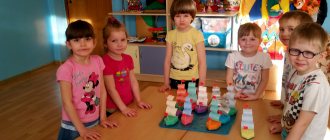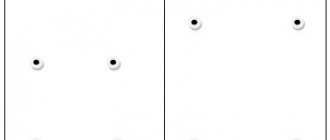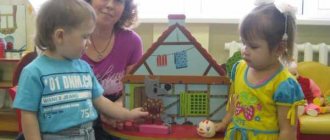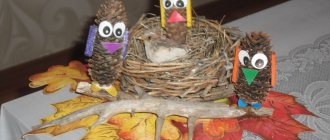Creative project on technical design in the second junior group “Techno-kids”
Municipal autonomous preschool educational institution "Buratino" of the city of Kogalym
Creative project on technical design in the second junior group “Techno-kids”
Prepared by the Teacher:
Yastrebova Galina Nikolaevna
Kogalym, 2020
Relevance:
The development of cognitive and creative abilities has now become one of the most important tasks in raising young children. This is the development of their mind, the formation of such thinking skills and abilities that make it easy to learn new things. Currently, research by scientists has convincingly proven that the capabilities of people who are usually called talented, genius are not an anomaly, but the norm. The task is only to liberate the child’s thinking, increase his efficiency, and finally, use the rich opportunities that nature has given him and the existence of which many are sometimes unaware of. Constructive activity, like play, according to teachers and psychologists, is one of the important types of activity in the development of a child’s cognitive and creative abilities, as it allows the child to arouse the need for creativity, develops logical, imaginative thinking, curiosity, communication, hard work, familiarity with norms and rules of relationships with peers and adults. Under the guidance of a teacher, a child, creating something beautiful, feels significant, skillful, and capable. Constructive activity is important for the harmonious development of a preschooler: improves fine motor skills; forms independence in the child: the desire to achieve goals, creativity; develops aesthetic feelings; the baby gains important experience in exploratory behavior
Objective of the project:
Development of cognitive and creative abilities in children of primary preschool age in the process of constructive activity. Development of perception, thinking and imagination
Tasks:
Promote the emergence and development of positive emotions and interest in playing with building materials;
Create conditions for experimentation and free design,
playing around with buildings;
Introduce basic building parts - recognition, discrimination, correct naming, free use for their intended purpose, taking into account characteristic features and properties
Learn to examine and analyze a sample.
Develop imagination, motor skills, auditory perception, speech, memory, thinking, vocabulary, gaming skills.
Improve memory, perseverance, and creativity.
.Develop the ability to play without quarreling, help each other and enjoy success together
Project scope:
The project involves teachers, children and parents of the younger group.
Project Description
The project consists of III stages.
Stage I - September - December 2022.
The beginning of construction work with kindergarten children is to teach children how to make statistical constructions: a tower, a house, a fence, a crib, a table, a chair. Little designers are guided by what an adult can demonstrate and build according to a ready-made model. The parts used here are only cubes or only bricks, bars, as well as a combination of two different geometric shapes - a cube and a brick, a cube and a prism, a brick and a prism.
Stage II - January - March 2022.
At the second stage of the project, training is conducted in the design of buildings that have some signs of dynamism: a car, an airplane, a boat, a train. Children are happy that they can roll toys on these structures. The parts are a block and a cube, 2 bars or 2 plates, a block and a triangular prism. From the parts: 2 cylinders, plates, a cube and a block, the children were able to build a car.
Stage III - April, May.
Construction is carried out on the initiative of the teacher, children provide the parts necessary for a particular building. Playing on the “Journey to Toy City” design.
Results achieved:
Construction classes develop children's sensory and thinking abilities.
Children acquire:
1.Constructive and technical skills: to construct individual objects from building material according to a model.
2. Generalized skills: purposefully examine objects, compare them with each other and divide them into parts, see what is common and different in them, find the main structural parts on which the arrangement of other parts depends. Constructive activity promotes practical knowledge of the properties of geometric bodies and spatial relationships: - children’s speech is enriched with new terms and concepts (bar, cube, pyramid, etc.), which are rarely used in other types of activities; - children practice the correct use of concepts (tall - low, long - short, wide - narrow, large - small), in precise verbal indication of direction (above - below, right - left, down - up, behind - in front, closer, etc. .d.).
Constructive activity is also a means of moral education of preschool children. In the process of this activity, important personality qualities are formed:
-hard work, -independence, -initiative, -persistence in achieving goals, -organization. Joint constructive activities of children (collective buildings, crafts) play a big role in developing the initial skills of working in a team:
-the ability to negotiate in advance (distribute responsibilities, select the material necessary to complete a building or craft, plan the process of their manufacture, etc.);
-work together without interfering with each other.
Social significance of the project:
Constructive activity is an effective means of aesthetic education. When children are introduced to buildings and structures (residential buildings, buildings of kindergartens, schools, etc.), as well as architectural monuments that are accessible to their understanding, they develop an artistic taste that causes aesthetic pleasure when looking at beautiful structures, and the ability to appreciate what has been created is formed. creative work of people, to love the architectural riches of their city, country, to take care of them.
The early development of interest in design and modeling among preschoolers stimulates children's scientific and technical creativity.
Activities carried out within the framework of the project:
1. Consultation for parents “Children’s games using construction sets”
2. Collective work of children on traffic safety: designing a road, a car. The product of children's activity does not yet have social significance; the child does not contribute anything new either to the material or cultural values of society. However, the guidance of children's activities by adults has the most beneficial effect on the labor education of preschoolers. It seems that the child is interested in the constructive process itself, as if he is mastering something new, complex, and interesting in it. But this visual design still contains the main content of constructive and technical activity. If a child does not use a craft in his practice, then when creating it, he tries to display in it, if possible, everything that is necessary for the action. It should be noted that often in the visual design of his buildings the child achieves a much greater resemblance to surrounding objects than when they are intended for direct practical use in play, while in buildings for play the child allows for more conventions. Target:
Development of cognitive and creative abilities in children of primary preschool age in the process of constructive activity. Objectives: 1. To promote the development of children's interest in constructive activities 2. To form cognitive and research activity in preschoolers, the desire for mental activity; 3. Introduce children to the world of technical and artistic invention; 4. Develop aesthetic taste, design skills and abilities.
Long-term work plan for
O.E. Litvinova
September
"Tall multi-colored towers made of cubes"
Software tasks.
Practice the ability to place cube on cube, matching the cubes by color. Support children's desire to build on their own.
Theme "Pyramid of cubes"
Software tasks.
Practice the ability to place cube on cube, matching the cubes by size. Teach to carefully remove parts after class, dismantling the building from above.
“Let’s help Petya build a fence for his garden”
Program tasks
- form ideas about the height of objects (high - low); — trace the connections between the design of the fence and its purpose; — introduce children to methods of constructing fences and the structural capabilities of various parts; — teach children to correlate their buildings with the existing model.
“Let’s build a red path in the garden”
Program tasks
-Teach children to independently select the necessary parts by size and color; -Form the perception of color, help children examine objects, highlighting their color; -Learn to name an object by its shape (cube); -Develop imagination, memory, imaginative thinking; — Develop fine motor skills of the hands.
“We learn by playing!”
Program tasks
Getting to know Lego - the designer.
Develop visual and effective thinking. Introduce Lego constructors. “Turret, Bridge”
Program tasks
Learn to build simple buildings. Develop a caring attitude towards the designer
October
Theme: “Wide and Narrow Paths”
Software tasks.
Practice the ability to construct buildings according to your own plans, using previously acquired skills. Accustom to carefully disassemble buildings, putting parts in boxes
"Tracks"
Program tasks
To develop the ability to build paths by changing their length, adding or replacing parts. Develop an interest in design
"Hut for Three Bears"
»
Program tasks
-Develop children's design skills; -Exercise in the construction of durable buildings; - Practice identifying and naming basic geometric shapes; — Develop imagination, creativity, and the ability to independently perform a sequence of actions.
November
"Let's build a wardrobe
»
Program tasks
-To strengthen the skills of firmly connecting parts according to the model (cabinet); -Teach children to correlate their actions with the rule and model of construction
Theme "Bed"
Software tasks.
Develop the ability to change buildings in two ways: by replacing some parts with others or adding width to them (narrow and wide beds). Develop a desire to build buildings yourself.
Encourage them to play around with buildings together
Topic: “What do we sit on (chair, sofa, armchair)”
Software tasks.
Exercise the ability to construct buildings according to your own plans, using previously acquired skills (laying, attaching, applying), using parts of different colors in buildings. Create a feeling of joy when creating a building yourself.
Accustom to carefully put parts in a box
December
"Fence"
Program tasks
Develop the ability to erect a structure without relying on a model, according to verbal instructions. Encourage playing together.
"Garage for a car"
Program tasks
Identify children’s skills in constructing a structure, analyze a sample, highlighting the main parts of the structure, the parts from which these parts are built; change the height of the building. Identify the degree of independence in the construction of a building
Theme "Gate"
Software tasks.
Learn to place cubes vertically and make floors from bricks. Learn to complement the construction with a prism or flag. Strengthen knowledge of the names of parts. Strengthen the ability to play around with buildings.
Topic “Different gates” Program tasks.
Strengthen the ability to build gates, supplement them with details. Encourage the building to be converted in height. Encourage play with the building
January
"Bus for animals"
Program tasks
Teach children how to build a building, attach and overlap parts, use various parts of the construction set, and make the building stable.
“House for toys”
Program tasks
Develop the ability to close space. Continue to develop the ability to analyze a sample with the help of a teacher, build a building to demonstrate construction methods. Learn to carefully dismantle the building. to form in children a stable interest in constructive activities; desire to experiment, create, invent; develop attention, ability to concentrate, memory, logical thinking; small muscles of the hands (motility);
February
Theme "Teremok for the Snow Maiden"
Software tasks.
Continue to learn how to install parts on a narrow surface, make ceilings, decorate and play with the building. Teach them to carefully dismantle the building.
Theme “Doll Katya is waiting for guests”
Software tasks.
Exercise the ability to construct buildings according to your own plans, using previously acquired skills (laying, attaching, applying), placing bricks vertically, placing them on buildings with parts of different colors. Cultivate friendly, polite communication with peers
"Machine for rabbits"
develop fine motor skills of the hands;
cultivate a desire to work; promote the development of creative imagination; develop memory, creative thinking; “Magic fish”
Program tasks
Learn to build fish from a construction set
"Design by Design"
Software tasks.
Encourage them to repeat familiar buildings on their own. Strengthen the skills of installing construction parts on wide and narrow edges horizontally and vertically, close to each other and at a distance. Encourage playing together.
March
Bus theme
Software tasks.
Reinforce the idea of a bus and its parts. Encourage building a bus by placing bricks tightly together and stacking them on top of each other. Introduce a new part with a cylinder. Encourage them to play with buildings. Develop the ability to sequentially disassemble a building, carefully place parts, and the desire to provide assistance.
April
Theme "Kindergarten for Matryoshka"
Software tasks.
Strengthen the ability to enclose a space, install bricks on a narrow edge vertically and horizontally, alternating in color. Reinforce the use of words: big, smaller, smallest. Attach the name of the builder's parts.
Arouse a desire to play with buildings, encourage joint games.
Theme: Fence for poultry and animals"
Software tasks.
Exercise the ability to place bricks vertically along the perimeter of a quadrangle, placing them at a certain distance (fence)
“Design by Design” Programming tasks
Reinforce acquired skills. Learn to think about the content of a future building in advance, name its theme, and give a general description. Develop
creative initiative and independence.
"Ship"
Program tasks
Learn to build a more complex structure. Develop attention and design skills.
May
Theme “Sand yard for large and small dolls”
Software tasks.
Strengthen the ability to build according to conditions.
Theme "My city"
Software tasks.
To consolidate the idea of the immediate surroundings. To learn to build multi-story buildings, strengthening the foundation of the building, and decorate with additional details. Reinforce knowledge of builder's details.
Encourage initiative and creativity.
Cultivate a polite, friendly attitude towards peers.
"Magic Snake"
Program tasks
Introduce children to the method of constructing a bending snake. Develop the ability to work in a team.
"Design by Design"
Program tasks
Reinforce acquired skills. Learn in advance, think about the content
future construction, name its theme, give a general description. Develop creative initiative and independence.
Designing furniture according to your own ideas
“Road for the Car” “Pen for Pets”
“Gate for a truck”
“Car” “Sofa”
Lego Construction
Target:
development of initial engineering skills, imagination, fine motor skills of preschool children while playing with LEGO.
Tasks:
Creating favorable conditions for the development of initial skills in Lego construction in preschool children.
List of used literature:
- N.S.Golitsyna Notes of complex thematic classes. Integrated approach. Moscow “SKIPTORIY2003 Publishing House” 2016
- O.E. Litvinova. Construction with children of early preschool age. Notes on joint activities with children 3-4 years old. St. Petersburg CHILDHOOD – PRESS2015
- I.A.Lykova “Design in kindergarten. Second junior group"
- Fishina E.V. Lego - Construction in kindergarten M...TC "Sphere" 20012.




